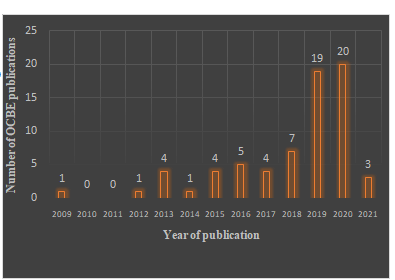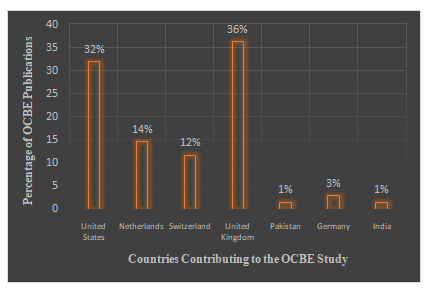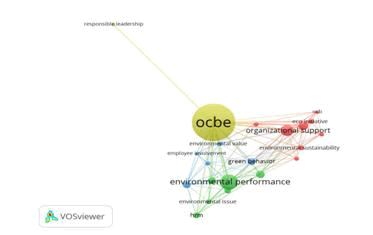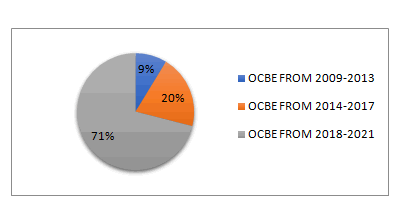Research Article: 2021 Vol: 20 Issue: 6S
Knowing Trends in Organizational Citizenship Behavior for the Environment (OCBE) using Bibliometric Analysis Based on the Scopus Database
Mia Ayu Gusti, Universitas Negeri Padang
Yasri Yasri, Universitas Negeri Padang
Idris Idris, Universitas Negeri Padang
Abstract
Objective: The literature on OCBE trends is limited. Therefore, it is important to carry out a bibliometric analysis aimed at knowing the trend of publication analysis in OCBE. Bibliometric analysis was used to search the Scopus database from the oldest publication in 2009 to the newest issue in 2021. The purpose of this study was to determine the number of papers, trend of increasing and leading countries, leading journals, most frequently appearing variables and emerging themes, as well as leading authors in OCBE field. Methodology:This study uses a bibliometric method to analyze and visualize OCBE trends. In searching the Scopus database, assisted by Harzing's Publish or Perish software, mendeley and VOSviewer. Results: From 2009 to 2021 there were 69 papers in the Scopus database discussing the OCBE study and from 2019 to 2020 there was an increase in publications in the OCBE study. The leading countries in OCBE research are the United Kingdom and United States. The OCBE concept is published in a leading journal, namely the Tourism Management journal. Then environmental performance has the closest relationship with OCBE which shows that OCBE is active in the field of environmental management pioneered by Charbel José Chiappetta Jabbour from the United Kingdom. Implication: In addition to providing direction and opportunities for future study. This study can also be useful for academics, organizations, and business policymakers in understanding OCBE trends.
Keywords
OCBE, Bibliometric Analysis, Harzing's Publish or Perish, Mendeley, VOS Viewer
Introduction
Globally, researchers and environmental policymakers have agreed on the fact that the reasons for environmental damage such as resource deficits, increased pollution and loss of biodiversity are caused by human behavior (Anwar, Mahmood, Yusliza, Ramayah, Faezah & Khalid, 2020). Responding to this, organizations are required to pay more attention to the implementation of green behavior for employees because employees are a major component in the organization (Boiral, 2009). Therefore, attention should be paid to OCBE. OCBE refers to discretionary and environmentally friendly behavior that is not explicitly recognized by the formal reward system (Boiral, 2009; Mi, Gan, Xu, Long, Qiao & Zhu, 2019; Mi, Gan, Xu, Long, Qiao & Zhu, 2019) and this behavior is also referred to as pro-environmental employee behavior (Anwar, Mahmood, Yusliza, Ramayah & Faezah, 2020; Paillé & Boiral, 2013).
The OCBE study provides various types of initiatives such as sharing knowledge to prevent pollution in the workplace, providing solutions to reduce waste, and collaborating with environmental departments to implement environmentally friendly technologies that ultimately have a significant impact on improving environmental performance(Boiral, 2005; Boiral & Paillé, 2012; Pham, Tu?ková & Jabbour, 2019). For this reason, the term OCBE has become increasingly interesting in recent years because currently organizational thinking has shifted from economic to ecological and social thinking which can bereferred to as a triple bottom line which then pays attention to how organizations can preserve the environment and create competitive advantages (Elkington, 1998).
With the increasing trend in the OCBE field, a bibliometric review is very important to do, the aim is to highlight the development of literature related to OCBE with the following research questions:
RQ1: What is the number of papers, the increasing trend and countries contributing to the OCBE field?
RQ2: Determine the leading journals in the OCBE study as seen from the Quartile, Cite Score, Source Normalized Impact per Paper (SNIP), Scimago Journal and Country Rank (SJR), and publishers?
RQ3: What are the most frequently occurring variables in OCBE and the themes that appear in OCBE?
RQ4: Who is the leading author in the OCBE field who has the most h-indexes rated by Scopus?
Method
Bibliometric assessments have become very important to use in recent years because they provide detailed information on certain topics (Van Eck & Waltman, 2017; White & McCain, 1998). According to (Garfield, 1955) bibliometrics is a method that accumulates various mathematical tools and statistical techniques for examining and scanning publications, for example, articles, various books, book chapters, etc. It is a process by which statistical methods are applied to explain scientific research topics and draw attention to trends in scientific disciplines (De Bakker, Groenewegen, & Den Hond, 2005; Bouyssou & Marchant, 2011). Bibliometric method is new and innovative compared to conventional framework building, Thus bibliometric analysis helps readers to know about past trends in topics, highlights progress in topics and provides space for further research (Durieux & Gevenois, 2010).
Choosing the Database
The first step in bibliometric analysis is to find a database that will support the research objectives. For this reason, the data source used is a reliable and appropriate data source, the aim of which is to complete the analysis and make the right choice (Rueda, Gerdsri & Kocaoglu, 2007). Crossref, Google Scholar, Microsoft Academic, Scopus, and Web of Science are reliable sources of data. The data source used in this study is Scopus, is the most prominent database used by researchers globally. To search the database, researchers were assisted by Harzing's Publish or Perish software and Mendeley.
Scope of Search
The scope of this bibliometric analysis includes only the study of OCBE. This study focuses on OCBE and does not include related topics such as OCB. Then we deleted studies that did not specifically address OCBE. For example, studies that use the words environment and sustainable development as keywords without specifying such an OCBE approach are not added to this study.
Search Criteria
OCBE-related article searches were used in two different combinations. In the search option, the keywords OCBE and Organizational Citizenship Behavior Environment (OCBE) are used. At this stage, the system shows that there are 269 documents related to OCBE. Then, as a whole the abstracts of all documents were studied. There were 200 unrelated documents and were deleted in this study because this document discusses OCB and the rest are 69 documents that discuss OCBE which are then analyzed further.
Measurement
To check the relationship between the most frequently cited authors, collaboration between different authors, coordination between countries, institutions, keywords, and knowledge related to the topic can use the VOS viewer software to analyze these (Hoppen & de Souza Vanz, 2016). VOS viewer can also be used for cluster analysis by drawing a geographic network map via a matrix that tells bunch of co-authorship and co-occurrence (Van Eck & Waltman, 2010).
Results
The research results are presented in relation to the four research objectives discussed above.
Number of Papers, Increasing Trend and Leading Countries Contributing to the Development of OCBE Studies at the global Level
From 2009 to the present, the number of documents in the Scopus database related to OCBE is 69 documents in the form of articles. Figure 1 shows the increasing trend of OCBE publications.
From the Figure 2 above, a number of information is obtained, OCBE's first publication was in 2009 and no research was published until 2011. From 2012 onwards, the number of OCBE publications has continued to increase. From 2019 to 2020 there was a rapid increase in the idea of OCBE, this is because the idea of OCBE has become very important in the eyes of scholars. The 69 articles published in Scopus, there were 39 articles published that year. Therefore, the upward trend in this graph shows that OCBE is still a new concept which is believed to be increasingly developing in the future.
The Figure above provides information that more than 30% of publications are dominated by the United Kingdom and the United States, meaning that these two countries are the main contributors in the OCBE study. United Kingdom has the most publications with 25 publications, covering 36% of publications at the global level. Then the United States was ranked the second most productive country in OCBE publications with 22 publications.
The Leading Journal in OCBE Studies
The OCBE concept has been published in various journals which can be seen in Table 1. The table shows that there are eleven leading journals that discuss OCBE studies from five publishers consisting of Elsevier, SAGE, Wiley-Blackwell, Emerald, and Springer Nature. Of the five publishers, Elsevier and SAGE have the most journals, where eight of the eleven journals come from the two publishers. The eleven journals are in Quartile 1 (Q1).
| Table 1 Leading Journals in the Ocbe Study |
||||||
|---|---|---|---|---|---|---|
| Number | Journal Name | Quartile | Cite score 2019 | SNIP | SJR | Publishers |
| 1 | Tourism Management | Q1 | 12.8 | 3.8 | 3.07 | Elsevier |
| 2 | International Journal of Project Management | Q1 | 13.0 | 3.6 | 2.66 | Elsevier |
| 3 | Journal of Cleaner Production | Q1 | 10.9 | 2.4 | 1.89 | Elsevier |
| 4 | Business & Society | Q1 | 9.4 | 2.4 | 1.80 | SAGE |
| 5 | Organization and Environment | Q1 | 9.1 | 2.2 | 2.08 | SAGE |
| 6 | International Journal of Hospitality Management | Q1 | 8.0 | 3.0 | 2.22 | Elsevier |
| 7 | Business Strategy and the Environment | Q1 | 8.4 | 1.9 | 1.83 | Wiley-Blackwell |
| 8 | human relations | Q1 | 7.1 | 3.0 | 2.52 | SAGE |
| 9 | International Journal of Contemporary Hospitality Management | Q1 | 7.2 | 2.3 | 2.20 | Emerald |
| 10 | Journal of Business Ethics | Q1 | 7.0 | 2.7 | 1.97 | Springer Nature |
| 11 | Journal of environmental management | Q1 | 7.6 | 1.8 | 1.32 | Elsevier |
Apart from looking at the Publisher and Quartile, it can also be evaluated through the Cite score, SNIP, and SJR to assess these leading journals. Emphasized by (Khudzari, Kurian, Tartakovsky & Raghavan, 2018) CiteScore has been seen by researchers as one of the criteria in the process of selecting journals to publish their work. According to the CiteScore 2019 analysis, the journal with the highest Cite Score is the International Journal of Project Management (13.0). A cite Score of 13.0 means that each article published in the Journal of Project Management has received an average of thirteen citations in the current year. Meanwhile, the Journal of Business Ethics received an average of seven citations in the current year because the Journal of Business Ethics Cite Score score was (7.0) lower than other journals.
The journal that has greater prestige is Tourism Management with a SJR value of 3.07 and the journal with the lowest prestige is the Journal of environmental management with a SJR value of 1.32. This is based on (Mingers & Yang, 2016) that a higher SJR value indicates greater journal prestige. Finally evaluating SNIP, among eleven journals, Tourism Management has the highest SNIP value with a value of 3.8 and the International Journal of Project Management has the second highest SNIP with a value of 3.6 and the lowest SNIP value is found in the Journal of environmental management with a value of 1.8.
Variables Appear most Frequently in OCBE and Themes that Appear in OCBE
Based on the network visualization mode in VOS viewer, showing the variables that appear most frequently in OCBE can be seen in Figure 3. Based on this figure, it can be seen that there are several large nodes that form OCBE including environmental performance, organizational support, pro environmental behavior, environmental sustainability, and green human resource management. These variables appear most frequently in the OCBE field.
However, it should be noted that there are several variables that are in the developing stage and are getting more attention even though the size of the nodes is not very large. These variables include responsible leadership, organizational commitment, green training, employee involvement, environmental value, and corporate social responsibility.
Likewise, the author also observes emerging themes in the OCBE field. The author divides the article into 3 phases every 4 years from 2009 to 2013, 2014 to 2017, and 2018 to 2021. In the early years of OCBE from 2009 to 2013 which represented 9 percent of the total document range, themes that emerged were environmental performance, organizational citizenship behavior, organizational commitment, supervisory support, corporate social performance, environmental concerns, corporate greening, eco-initiatives, employee participation, environmental management, sustainability, job attitude, perceived organizational support, extra-role behavior, employee commitment, green behavior, pro-environmental behavior, environmental strategy, ISO14000 and ISO 9000 series (Figure 4).
Mid-year from 2014 to 2017 which shows 20 percent of the total documents emphasize the importance of organizational identification, the importance of socially responsible companies, applying psychological empowerment, studying environmentally friendly behavior, proposing environmentally friendly brands and products, the need for a social identity theory to shape responsibility and commitment to the environment, proposing organizational justice in relation to OCBE and to implement this behavior requires personality characteristics and employee involvement as well as the need for strategic human resource management in implementing OCBE behavior.
Finally, 2018 to 2021 was a pioneer year in the OCBE study because there was a significant increase in the OCBE study which represented 49 percent of the range of articles on the OCBE study which emphasized the importance of employee safety in the workplace, creating environmentally friendly employees through environmental training, and such an environmentally friendly human resource management process is focused on employees, especially until now in 2021 the trend that appears in the OCBE study is to concentrate more on their leaders such as the ethics of a leader, responsible leadership is needed, and a leadership style is needed to be able to change. Employee behavior becomes environmentally friendly employee behavior that can create sustainable development.
Leading Authors in the OCBE Field
Another advantage of bibliometric studies is can tell about leading authors in a particular field (McCain, 1990; Nerur, Rasheed & Natarajan, 2008; White & McCain, 1998). The leading authors in the OCBE field who had the most h-indexes rated by Scopus between 2009 and 2021 were Charbel José Chiappetta Jabbour with 43 h-index followed by Thurasamy Ramayah, Woo Gon Kim, Kathryn Mearns, and Talya N Bauer. Therefore, this study only analyzes some of the best authors in the field of OCBE who support the argument that OCBE is still a new concept that is currently developing (Table 2).
| Table 2 Top Ten Authors In The Ocbe Field Rated By Scopus |
||||||
|---|---|---|---|---|---|---|
| Ranking | Authors | Documents | h-index | Affiliation | City | Country |
| 1 | Jabbour, C. J. C. | 220 | 43 | University of Lincoln | Lincoln | United Kingdom |
| 2 | Ramayah, T. | 417 | 41 | UniversitiSains Malaysia | Gelugor | Malaysia |
| 3 | Kim, W.G. | 125 | 38 | Kyung Hee University | Seoul | South Korea |
| 4 | Mearns, K. | 112 | 38 | John Wood Group PLC | Aberdeen | United Kingdom |
| 5 | Bauer, T. N. | 101 | 37 | Portland State University | Portland | United States |
| 6 | Boiral, O. | 96 | 36 | Université Laval | Quebec | Canada |
| 7 | Long, R. | 174 | 32 | China University of Mining and Technology | Xuzhou | China |
| 8 | Cooke, F.L. | 168 | 30 | Monash University | Melbourne | Australia |
| 9 | Chen, Y.S. | 74 | 28 | National Taipei University | Taipei | Taiwan |
| 10 | Iraldo, F. | 88 | 27 | Universitarie diPerfezionamento | Pisa | Italy |
From the table above, it can be concluded that Charbel José Chiappetta Jabbour is the most prominent and dominant researcher in the OCBE field because he has the highest h-index compared to other authors. His contribution to the OCBE field mainly focuses on creating an environmentally friendly industry (Pham et al., 2019).
Discussion
This study conducted a bibliometric analysis of the OCBE field from 2009 to 2021 based on information available in the Scopus database. The aim of the bibliometric analysis is to determine research trends and popular issues in the OCBE field. This study thus provides direction to researchers and scholars who are interested in studying OCBE plus it provides information on past, current, and future advances in the OCBE field to develop conceptual and theoretical models.
2019 and 2020 are pioneering years in the analysis of OCBE developments. In addition, detection of the latest topics that must be linked to OCBE can also be carried out, such as responsible leadership, organizational commitment, green training, employee involvement, environmental value, and corporate social responsibility. In addition, the OCBE study was conducted mainly in the United Kingdom, although other countries also made efforts to increase their knowledge of OCBE. More coordination between countries will provide an overall picture of OCBE.
The main foundation of OCBE lies in the business and management domains, therefore journals related to management are Tourism Management which has the highest Quartile, Cite Score, SNIP, SJR. Finally, Charbel José Chiappetta Jabbour is a pioneer in the OCBE study because he has the highest h-index compared to other authors. This study also shows that research on OCBE is relatively new and its foundation lies in business and management but its roots are in the literature related to environmental science.
Conclusions, Limitations and Future Research
The OCBE study has seen enormous growth since 2009 especially in recent years, which has had a major impact on the literature. Conclusively, OCBE is a topic that has developed recently and is currently of great importance to industry and academia. There are differences in studying OCBE in different countries. Therefore cross cultural studies must be carried out.
However, the results described above have several limitations namely this research relies on documents published in Scopus and the problem of a different researcher with the same name is also a problem in this method.
For further study, researchers may consider bibliometric analysis using other databases such as google scholar and Web of Science which will add further information to this field. Further studies should also be carried out to find the relationship between different variables in the OCBE field using sociograms.
References
- Anwar, N., Mahmood, N.H.N., Yusliza, M.F., Ramayah, T., Faezah, J.N., & Khalid, W. (2020). Green human resource management for organisational citizenship behaviour towards the environment and environmental performance on a university campus. Journal of Cleaner Production, 256, 1–13.
- Boiral, O. (2005). The impact of operator involvement in pollution reduction: Case studies in Canadian chemical companies. Business Strategy and the Environment, 14(6), 339–360.
- Boiral, O. (2009). Greening the corporation through organizational citizenship behaviors. Journal of Business Ethics, 87(2), 221–236.
- Boiral, O., & Paillé, P. (2012). Organizational citizenship behaviour for the environment: Measurement and validation. Journal of Business Ethics, 109(4), 431–445.
- Bouyssou, D., & Marchant, T. (2011). Bibliometric rankings of journals based on impact factors: An axiomatic approach. Journal of Informetrics, 5(1), 75–86.
- Chang, T.W., Chen, F.F., Luan, H.D., & Chen, Y.S. (2019). Effect of green organizational identity, green shared vision, and organizational citizenship behavior for the environment on green product development performance. Sustainability, 11(3), 1–17.
- Wang, C.Y., Cooke, F.L.Y., Lin, L. (2021). Is abusive supervision harmful to organizational environmental performance? Evidence from China. Asian Business and Management. https://doi.org/10.1057/s41291-021-00148-0
- De Bakker, F.G.A., Groenewegen, P., & Hond, F. (2005). A bibliometric analysis of 30 years of research and theory on corporate social responsibility and corporate social performance. Business & Society, 44(3), 283–317.
- Durieux, V., & Gevenois, P.A. (2010). Bibliometric indicators: Quality measurements of scientific publication. Radiology, 255(2), 342–351.
- Elkington, J. (1998). Accounting for the triple bottom line. Measuring Business Excellence.
- Erdogan, B., Bauer, T.N., & Taylor, S. (2015). Management commitment to the ecological environment and employees: Implications for employee attitudes and citizenship behaviors. Human Relations, 1–23.
- Garfield, E. (1955). Citation indexes for science. Science, 122(3159), 108–111.
- Hoppen, N.H.F., & Vanz, S.A. (2016). Neurosciences in Brazil: A bibliometric study of main characteristics, collaboration and citations. Scientometrics, 109(1), 121–141.
- Khudzari, J.M., Kurian, J., Tartakovsky, B., & Raghavan, G.S.V. (2018). Bibliometric analysis of global research trends on microbial fuel cells using Scopus database. Biochemical Engineering Journal, 136, 51–60.
- Kim, W.G., McGinley, S., Choi, H.M. (2020). Hotels’ environmental leadership and employees’ organizational citizenship behavior. International Journal of Hospitality Management, 87.
- McCain, K.W. (1990). Mapping authors in intellectual space: A technical overview. Journal of the American Society for Information Science, 41(6), 433–443.
- Mi, L., Gan, X., Xu, T., Long, R., Qiao, L., Zhu, H. (2019). A new perspective to promote organizational citizenship behaviour for the environment: The role of transformational leadership. Journal of Cleaner Production, 239, 1–11.
- Nerur, S.P., Rasheed, A.A., & Natarajan, V. (2008). The intellectual structure of the strategic management field: An author co-citation analysis. Strategic Management Journal, 29(3), 319–336.
- Paillé, P., & Boiral, O. (2013). Pro-environmental behavior at work: Construct validity and determinants. Journal of Environmental Psychology, 36, 118–128.
- Pham, N.T., Tu?ková, Z., & Jabbour, C.J.C. (2019). Greening the hospitality industry: How do green human resource management practices influence organizational citizenship behavior in hotels? A mixed-methods study. Tourism Management, 72, 386–399.
- Rueda, G., Gerdsri, P., & Kocaoglu, D.F. (2007). Bibliometrics and social network analysis of the nanotechnology field. PICMET’07-2007 Portland International Conference on Management of Engineering & Technology, 2905–2911. IEEE.
- Temminck, E., Mearns, K., & Fruhen, L. (2015). Motivating employees towards sustainable behaviour. Business Strategy and the Environment, 24(6), 402–412.
- Testa, F., Corsini, F., Gusmerotti, N.M., & Iraldo, F. (2020). Predictors of organizational citizenship behavior in relation to environmental and health & safety issues. The International Journal of Human Resource Management, 31(13), 1705–1738.
- Umrani, W.A., Channa, N.A., Yousaf, A., Ahmed, U., Pahi, M.H., & Ramayah, T. (2020). Greening the workforce to achieve environmental performance in hotel industry: A serial mediation model. Journal of Hospitality and Tourism Management, 44, 50-60.
- Van Eck, N.J., & Waltman, L. (2010). Software survey: VOS viewer, a computer program for bibliometric mapping. Scientometrics, 84(2), 523–538.
- Van Eck, N.J., & Waltman, L. (2017). Citation-based clustering of publications using CitNetExplorer and VOSviewer. Scientometrics, 111(2), 1053–1070.
- White, H.D., & McCain, K.W. (1998). Visualizing a discipline: An author co-citation analysis of information science, 1972–1995. Journal of the American Society for Information Science, 49(4), 327–355.



